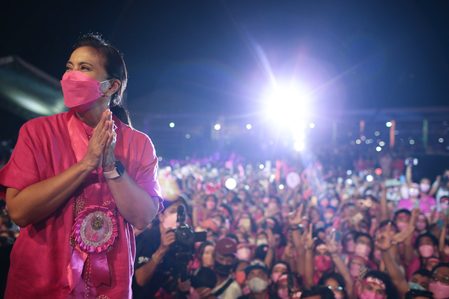SUMMARY
This is AI generated summarization, which may have errors. For context, always refer to the full article.
![[OPINION] Loving him was red: On the color-coding of Philippine politics](https://www.rappler.com/tachyon/2022/05/campaign-colors.jpg)
Last Easter Sunday, I came across a Facebook post that showed the archbishop and a priest donning a pink cassock. The caption (though I can’t say it verbatim) basically anticipated that a certain candidate’s camp would assume that the Catholic Church was endorsing Leni Robredo. Chill out, the post stated, pink is the color of Easter traditionally, and that won’t change because of political rivalry.
It made me think a lot about the color pink and how traditional – and often, trivial – signs, symbols, and figures take on a new form in the campaign season.
The post that came after that included this: “Namiss ko na mag peace sign.”
The peace sign was actually not a symbol of peace at first. Referred to mainly as the “V” sign, the gesture was actually synonymous with the middle finger before the Allies of World War II restructured its meaning into one of peace, universally. In this day and age, especially since the context is dated, the V sign is a common gesture used when taking photos, to symbolize that someone is having fun.
That’s why I have no fun now that I can’t strategically do the peace sign in photos.
When we were having a photo-op in an online summit I was attending, I instinctively raised my hands to do the sign. Once the screenshot was taken, one of the members unmuted their mic and joked: “Hala, may BBM pala dito.”
It reminded me a lot of JC De Vera’s captionless set of photographs where he did the peace sign. The comment section was flooded with green and red hearts after that, and JC himself had to comment on them one by one saying, “Nope.”
It reminded me of when I was with a friend once who pointed at the Italian flag and said, “BBM-Sara.”
Then, later on, another friend of mine would tell me that their mom wouldn’t buy a pink phone case because people might mistake her for a Kakampink.
I learned in my Media and Society class that there are two types of symbol analysis: semiotic and discourse. They pretty much tackle the same object, but the latter focuses more on the conversation that surrounds it. My teacher taught our class that the yellow ribbon was historically used as a symbol or reminder for military troops who were away from home. However, a 1973 song by Dawn called Tie a Yellow Ribbon Round the Ole Oak Tree used it as a symbol for a prisoner who had just been released from jail. The Filipinos used these yellow ribbons, then, to welcome Senator Beningno “Ninoy” Aquino Sr. back home after he was exiled to the United States. Across the ocean, this yellow ribbon has also been used for the disappearances of young girls. In Hong Kong, it symbolizes student boycotts. In South Korea, a tragic ferry sinking.
The meanings of these symbols don’t just come from what the symbols themselves tell us. They come from the context of the situations and conversations around them.
Foucault adds an interesting spin to it by focusing on the power that steers these conversations. Yes, we know pink is Leni, red is BBM, and green is Sara – but what does it say about the power of political structures when one person refuses to buy a phone case because of its color?
While assigning meanings to symbols is inescapable in politics, it has not only boxed us into our little echo chambers, but have also set these echo chambers further apart. Especially with how common these colors are, we restrict ourselves from choosing something because of the connotation underlying it and we restrict others from doing the same.
While for me the color pink symbolizes hope, this idea that we own the colors of our candidates is also a power play. A very dangerous one at that, because it blurs the line between how much power we have and how much we actually don’t. While we don with pride and puffed chests these pink shirts, red wristbands, and green shoes, we are not actually displaying our own power but the power of the people who assign meaning to these colors. The people who will in turn have power over us.
Camps do everything they can to try to find a color or a figure to represent the Filipino nation, but the conversations that surround them are actually very divisive. It’s no good, either, that people adopt colors that are supposed to already have their own symbolism in Filipino culture.
Prior to this election cycle, Filipinos would usually associate the color red with the one found in the Filipino flag. This color was chosen for the flag as it was used before by the Katipuneros as their flag color when revolting against colonization. It was incorporated into the national flag as a reminder of the patriotism and valor that these brave people exhibited.
Marcos’ camp chose this color for their campaign. It is plainly ironic to me because they don’t represent what people are fighting for but what people should be fighting against. There is no patriotism in stealing from the Filipino people, and no valor in running away from debates and tough questions.
Filipinos should be reminded that we are a diverse country with variedly cultured groups. It is not fair that we turn away from these cultures in election season. We cannot be relegated to just red, green, pink, or blue.
Candidates have been attempting to course-correct. Notably, Leni Robredo recently changed her campaign logo from all-pink to multi-colored. Her team did this to be more inclusive. They say that in a clean government, everyone is welcome.
It’s an impactful statement in a time when people are breaking friendships, arguing with family members, and fighting with online strangers to show their political stances. Signs and symbols have power. Most of the time, the power isn’t with the people. Whoever it should come from, however, should be thinking of the people when they make it. As important as these colors are, it is the conversations that surround them that define the Filipino community.
Let’s make those conversations meaningful. – Rappler.com
Aidan Bernales is a freshman Communications student at Ateneo de Manila University. He is currently a student mover under the MovePH Visayas team.
Add a comment
How does this make you feel?


![[WATCH] In The Public Square with John Nery: Preloaded elections?](https://www.rappler.com/tachyon/2023/04/In-the-Public-Square-LS-SQ.jpg?resize=257%2C257&crop=414px%2C0px%2C1080px%2C1080px)
![[Newspoint] 19 million reasons](https://www.rappler.com/tachyon/2022/12/Newspoint-19-million-reasons-December-31-2022.jpg?resize=257%2C257&crop=181px%2C0px%2C900px%2C900px)

![[OPINION] The long revolution: Voices from the ground](https://www.rappler.com/tachyon/2022/06/Long-revolution-June-30-2022.jpg?resize=257%2C257&crop=239px%2C0px%2C720px%2C720px)
![[OPINION] I was called a ‘terrorist supporter’ while observing the Philippine elections](https://www.rappler.com/tachyon/2022/06/RT-poster-blurred.jpeg?resize=257%2C257&crop_strategy=attention)
There are no comments yet. Add your comment to start the conversation.